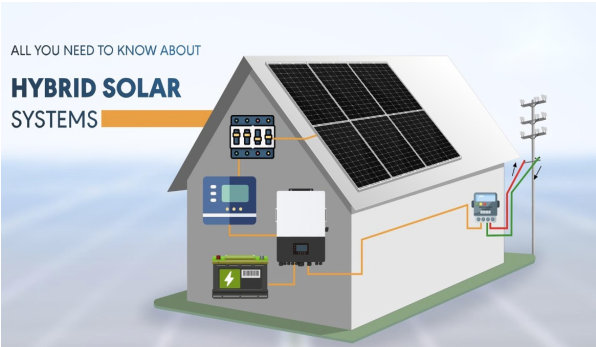Interest in renewable energy solutions has grown in recent years, and hybrid solar systems have become a versatile and innovative way to harness solar energy. In this article, we’ll take an in-depth look at hybrid solar systems to learn about their benefits, how they work, and installation considerations. Whether you’re looking for energy independence or backup power in the event of a grid outage, a hybrid solar system could be the answer to your sustainable energy needs.
What is a Hybrid Solar System?
A hybrid solar system combines the best features of grid-tied and off-grid solar systems to create an innovative and intelligent energy solution. This advanced energy system harmoniously combines solar panels, batteries and a state-of-the-art hybrid inverter, allowing homeowners to take full advantage of the sun’s energy while achieving unprecedented energy independence.
In essence, a hybrid solar system acts as a hybrid energy hub, efficiently managing the power generated by the solar panels, intelligently storing excess energy and ensuring continuous, uninterrupted power for your home, even during grid outages.

Advantages of Hybrid Solar Systems
1. Increased energy independence: Unlike traditional grid-tied systems that rely solely on the grid for power, hybrid solar systems allow you to control your energy destiny. By harnessing the sun’s energy and efficiently storing the excess in batteries, you can greatly reduce your dependence on the utility company and achieve a new level of energy independence.
2. Grid flexibility and backup power: On sunny days, when the solar panels produce more energy than you need, the battery charges the remaining energy. This stored energy becomes your lifeline on cloudy days or during power outages. The result is a seamless, continuous power supply, even when the grid is down.
3. Cost savings and energy management: You can realise potential cost savings by optimising solar energy consumption and using battery energy storage during peak periods. The system’s energy management features also allow you to monitor and fine-tune energy consumption, maximising efficiency and minimising waste.
Installing a Hybrid Solar System
Installing a hybrid solar system is a process that requires careful planning and expertise. Let’s walk through the key steps to help you get started:
1. Working with a reputable or certified solar company is essential to the successful implementation of a hybrid solar system. They have the expertise to conduct a comprehensive site assessment, evaluating your solar potential, energy consumption patterns and the optimal system size based on available roof space.
2. Determine system configuration: The design of your hybrid solar system should be based on your energy needs and goals. Battery capacity, energy usage patterns and desired level of energy independence are critical factors to consider during the system configuration phase. In addition, the installation must comply with local codes and safety standards.
3. The installation process: Installation begins with the installation of solar panels on your roof or ground mounting structures. These solar panels are connected to the hybrid inverter, the heart of the system. The hybrid inverter performs the essential tasks of converting the DC electricity from the solar panels into AC electricity for household use and charging the batteries with excess energy.
Post time: Aug-11-2023